Market Size of Aluminum Foil Packaging Industry

| Study Period | 2019 - 2029 |
| Market Size (2024) | USD 27.87 Billion |
| Market Size (2029) | USD 35.47 Billion |
| CAGR (2024 - 2029) | 4.94 % |
| Fastest Growing Market | Asia Pacific |
| Largest Market | Asia Pacific |
Major Players
*Disclaimer: Major Players sorted in no particular order |
Need a report that reflects how COVID-19 has impacted this market and its growth?
Aluminum Foil Packaging Market Analysis
The Aluminum Foil Packaging Market size is estimated at USD 27.87 billion in 2024, and is expected to reach USD 35.47 billion by 2029, growing at a CAGR of 4.94% during the forecast period (2024-2029).
The aluminum foil protects against moisture, light, oxygen, and bacteria, critical requirements for industries like food and beverage and pharmaceuticals. Aluminum foil is consumed majorly by the food and beverage industry. Aluminum composites prepared with paper products are in high demand due to the vast dairy industry. Additionally, aluminum foil is 88% reflective and is used for thermal insulation. The aluminum sheet also provides a protective vapor barrier, making them ideal for use in food packaging.
Sunlight quickly affects many groceries, damaging their appearance and taste. Foil is the most viable solution to cater to these packaging requirements, which led to the material being regarded as the ideal core packaging material for dairy products, pastries, and beverages. For instance, dry milk in hermetically sealed packages made from laminated foil has a shelf life of two years. A surge in other flexible packaging solutions usage might also be observed during the forecast period. The increased domestic demand for aluminum has led to an upsurge in aluminum foil imports from China, whose shipments to the United States increased significantly in the last decade. Today, flexible packaging is mainly used for food, with the fastest areas of expansion being coffee, snack foods, fresh produce, ready-to-eat meals, and pet food.
The market demand for aluminum foil packaging is expected to grow, owing to aluminum's lightweight, durability, flexibility, and barrier properties compared to plastic and glass. The ease of use, convenience, safety, lightweight, and durability of aluminum makes it ideal for use across various verticals and households.
The pharmaceutical business frequently uses blister packs for medicinal products. They comprise a push-through closure composed of aluminum foil known as blister film or lid film and the so-called push-through Blister, a molded plastic with cavities for individual tablets. For various items, different blister packing materials are employed in medicines. Mainly aluminum plastic packaging is employed in medicine packaging, while a few other medications use alu-all packaging.
Furthermore, Aluminum foil packaging, including aluminum wraps and containers for pharmaceuticals and online-ordered food, significantly increased in demand. The Aluminum Stewardship Initiative (ASI) sets many standards for social and environmental policies. The organization is expected to restore the disrupted supply chain for aluminum foil packaging materials caused by the nationwide lockdowns imposed due to the outbreak of COVID-19.
Aluminum's sustainability creates competitive business advantages while simultaneously providing product development advantages. According to the Aluminum Association, nearly 75% of all aluminum produced is still in use. Moreover, when disposed of, aluminum waste does not add poisonous contaminants to the water or ground; furthermore, it can be economically recycled and more sustainable.
The chain of suppliers for the raw materials used to make aluminum foil has been severely disrupted by the COVID-19 outbreak. It was explained by a shortage of resources and transportation, which resulted in restricted access, sluggish stock, and insufficient raw materials for manufacturing. The supply chain was distorted due to the numerous government restrictions on transferring commodities between nations. The transportation of raw materials was halted due to the supply chain disruption, which has slowed production. Similarly, there was an unmet demand for aluminum foil across a range of end users, including food, beverage, pharmaceutical, chemical manufacturing, and other industries. This was due to inflated costs and a halt in aluminum foil production.
